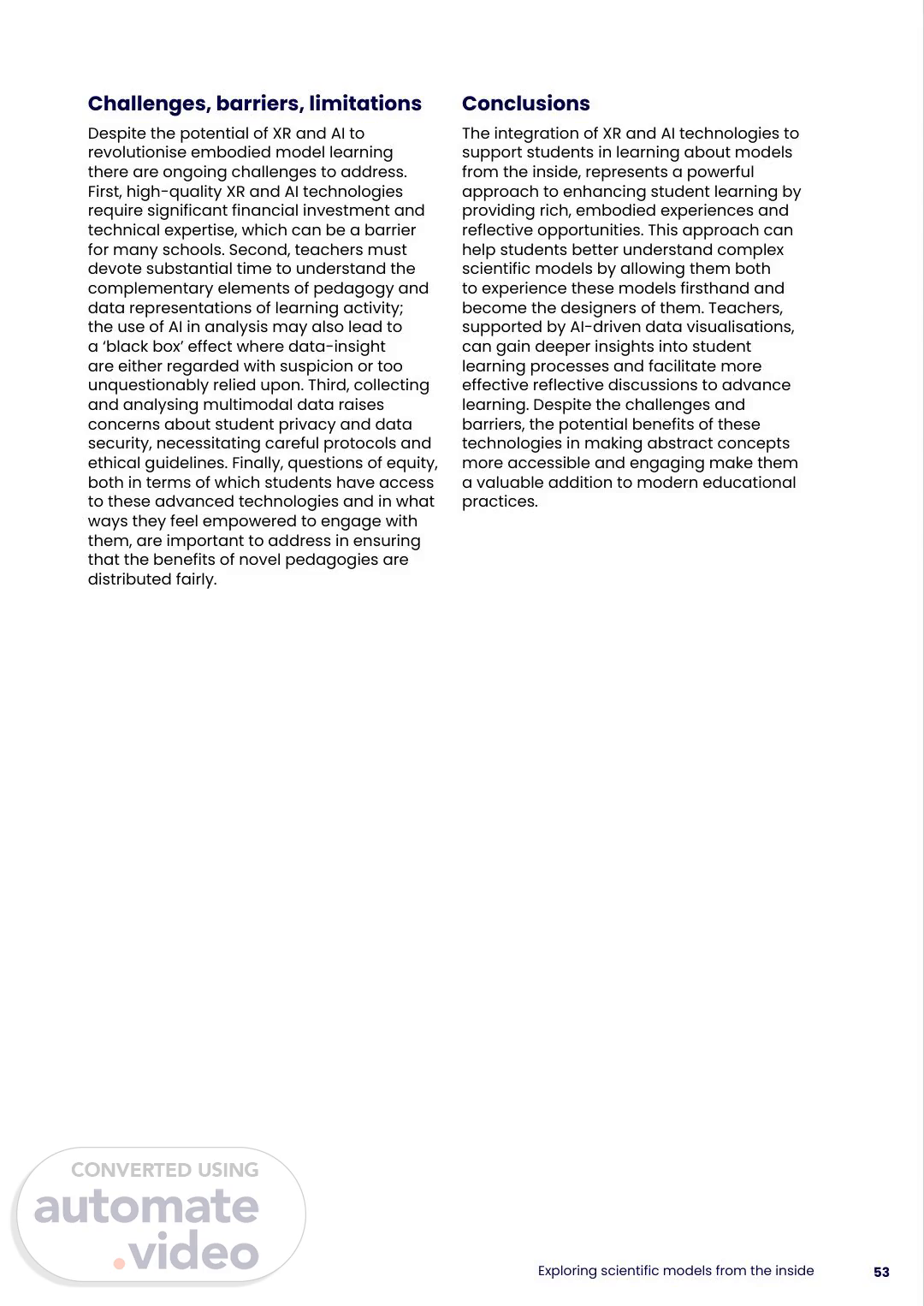Scene 1 (0s)
53 Exploring scientific models from the inside Challenges, barriers, limitations Despite the potential of XR and AI to revolutionise embodied model learning there are ongoing challenges to address. First, high-quality XR and AI technologies require significant financial investment and technical expertise, which can be a barrier for many schools. Second, teachers must devote substantial time to understand the complementary elements of pedagogy and data representations of learning activity; the use of AI in analysis may also lead to a ‘black box’ effect where data-insight are either regarded with suspicion or too unquestionably relied upon. Third, collecting and analysing multimodal data raises concerns about student privacy and data security, necessitating careful protocols and ethical guidelines. Finally, questions of equity, both in terms of which students have access to these advanced technologies and in what ways they feel empowered to engage with them, are important to address in ensuring that the benefits of novel pedagogies are distributed fairly. Conclusions The integration of XR and AI technologies to support students in learning about models from the inside, represents a powerful approach to enhancing student learning by providing rich, embodied experiences and reflective opportunities. This approach can help students better understand complex scientific models by allowing them both to experience these models firsthand and become the designers of them. Teachers, supported by AI-driven data visualisations, can gain deeper insights into student learning processes and facilitate more effective reflective discussions to advance learning. Despite the challenges and barriers, the potential benefits of these technologies in making abstract concepts more accessible and engaging make them a valuable addition to modern educational practices..
Scene 2 (1m 2s)
54 Innovating Pedagogy 2024 References 1. Short conference paper from the STEP project: Danish, J., Enyedy, N., Humburg, M., Saleh, A., Dahn, M., Lee, C., and Georgen, C. (2018) ‘STEP-Bees and the role of collective embodiment in supporting learning within a system’, in J. Kay and R. Luckin (Eds.) ICLS 2018 Proceedings: International conference of the learning sciences, pp. 1249– 1250. Available at: https://repository.isls.org/ bitstream/1/600/1/272.pdf (Accessed 4 July 2024). 2. A conference paper describing several projects: Moher, T., Slotta, J. D., Acosta, A., Cober, R., Dasgupta, C., Fong, C., ... and Peppler, K. (2015). Knowledge construction in the instrumented classroom: Supporting student investigations of their physical learning environment. pp. 631–638. CSCL 2015 Proceedings. International Society of the Learning Sciences, Inc. Available at: https://repository.isls.org/handle/1/449 (Accessed 3 July 2024). 3. A conference paper from the STEP project: Enyedy, N., Danish, J., DeLiema, D., Saleh, A., Lee, C., Morris, N., and Illum, R. (2017) ‘Social affordances of mixed reality learning environments: a case from the Science through Technology Enhanced Play project (STEP)’, Papers from Hawaii International Conference on System Sciences 2017. Available at: https://scholarspace.manoa.hawaii.edu/ items/28ac995d-1cfe-4f03-b9e9-7915522896fa (Accessed 4 July 2024). 4. Journal article: Lindgren, R., and Johnson-Glenberg, M. (2013) ‘Emboldened by embodiment: Six precepts for research on embodied learning and mixed reality’, Educational Researcher, 42(8), pp. 445–452. 5. Journal article: Enyedy, N., Danish, J. A., Delacruz, G., and Kumar, M. (2012) ‘Learning physics through play in an augmented reality environment’, International Journal of Computer-Supported Collaborative Learning, 7, pp. 347–378. 6. A conceptual piece in a book chapter describing the value of students’ ability to see things from different perspectives in creating deep understanding: Ackermann, E. (2012) ‘Perspective-taking and object construction: Two keys to learning’, in Y=. B. Kafai and M. Resnick (eds.) Constructionism in Practice, pp. 25–35. New York: Routledge. 7. Book chapter: Hall, R., and Stevens, R. (2015) ‘Interaction analysis approaches to knowledge in use’, in A. A. diSessa, M. Levin and N. J. S. Brown (eds.) Knowledge and Interaction, pp. 88–124. Routledge. Resources • STEP project website: Science through Technology Enhanced Play (STEP). GEM-STEP Example Models. Available at: https://embodiedplay.org/gem-step_examples/ (Accessed 4 July 2024). • Short article on GenAI and XR, discussing the application of the AI approach to XR learning: Levine, E. (2024) ‘The Next Frontier in Education: How generative AI and XR will evolve the world of learning in the next decade’, Qualcomm blog post, 15 May. Available at: https://www.qualcomm. com/news/onq/2024/05/the-next-frontier-in- education-how-generative-ai-and-xr-evolve- learning (Accessed 4 July 2024). • Feature article on several different applications of GenAI and XR (e.g., ‘Imagine learning about the history of ancient Rome, not from a textbook but standing in the Curia of Pompey next to Julius Caesar surrounded by angry senators, moments before the knives come out’): J. Hutson (2023) ‘Reinventing education through generative AI and XR’, Research Features. Available at: https://researchfeatures.com/ reinventing-education-generative-ai-xr/ (Accessed 4 July 2024)..
Scene 3 (2m 7s)
Innovating Pedagogy 2024 Exploring new forms of teaching, learning and assessment, to guide educators and policy makers Open University Innovation Report 12.
